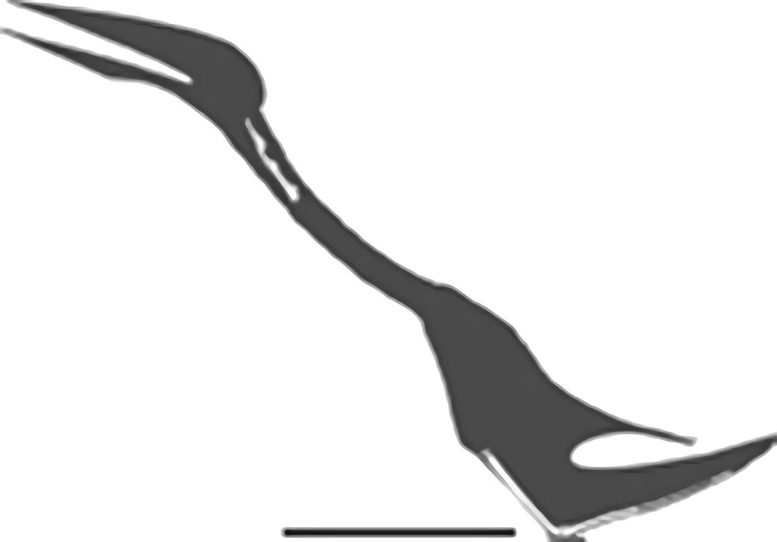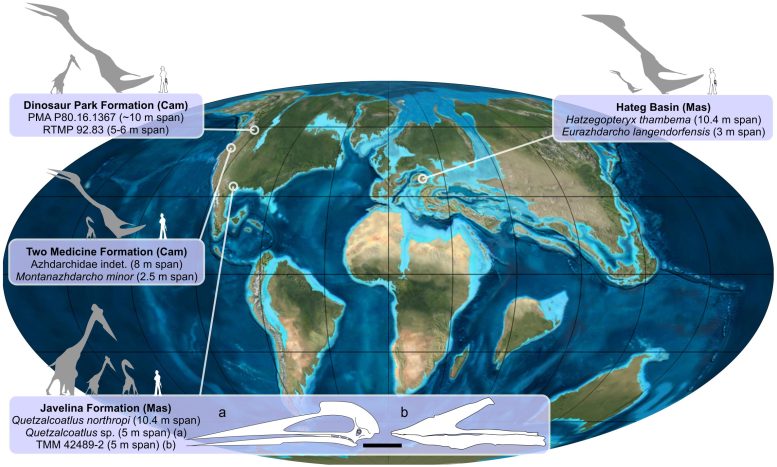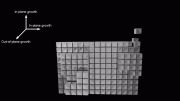
Full body reconstruction of Eurazhdarcho langendorfensis. Preserved skeletal elements are in white. Scale bar is 500 mm. Credit: Image courtesy of Mark Witton
Paleontologists have discovered the fossilized bones of a 68 million year old flying reptile, Eurazhdarcho langendorfensis, in the Transylvanian Basin of Romania.
A new kind of pterosaur, a flying reptile from the time of the dinosaurs, has been identified by scientists from the Transylvanian Museum Society in Romania, the University of Southampton in the UK and the Museau Nacional in Rio de Janiero, Brazil.
The fossilized bones come from the Late Cretaceous rocks of Sebeş-Glod in the Transylvanian Basin, Romania, which are approximately 68 million years old. The Transylvanian Basin is world-famous for its many Late Cretaceous fossils, including dinosaurs of many kinds, as well as fossilized mammals, turtles, lizards, and ancient relatives of crocodiles.
A paper on the new species, named Eurazhdarcho langendorfensis has been published in the international science journal PLoS One. Dr. Darren Naish, from the University of Southampton’s Vertebrate Palaeontology Research Group, who helped identify the new species, says:
“Eurazhdarcho belong to a group of pterosaurs called the azhdarchids. These were long-necked, long-beaked pterosaurs whose wings were strongly adapted for a soaring lifestyle. Several features of their wing and hind limb bones show that they could fold their wings up and walk on all fours when needed.
“With a three-meter wingspan, Eurazhdarcho would have been large, but not gigantic. This is true of many of the animals so far discovered in Romania; they were often unusually small compared to their relatives elsewhere.”
The discovery is the most complete example of an azhdarchid found in Europe so far and its discovery supports a long-argued theory about the behavior of these types of creatures.

Map to show the global distribution of faunas containing small-medium and giant-sized azhdarchids, evidence for niche partitioning. Credit: Image rendering courtesy of Mark Witton; map imagery by kind permission of Ron Blakey, Colorado Plateau Geosystems, Inc.
Dr. Gareth Dyke, Senior Lecturer in Vertebrate Palaeontology, based at the National Oceanography Center Southampton says:
“Experts have argued for years over the lifestyle and behavior of azhdarchids. It has been suggested that they grabbed prey from the water while in flight, that they patrolled wetlands and hunted in a heron or stork-like fashion, or that they were like gigantic sandpipers, hunting by pushing their long bills into mud.
“One of the newest ideas is that azhdarchids walked through forests, plains, and other places in search of small animal prey. Eurazhdarcho supports this view of azhdarchids, since these fossils come from an inland, continental environment where there were forests and plains as well as large, meandering rivers and swampy regions.”
Fossils from the region show that there were several places where both giant azhdarchids and small azhdarchids lived side by side. Eurazhdarcho’s discovery indicates that there were many different animals hunting different prey in the region at the same time, demonstrating a much more complicated picture of the Late Cretaceous world than first thought.
Reference: “A New Azhdarchid Pterosaur from the Late Cretaceous of the Transylvanian Basin, Romania: Implications for Azhdarchid Diversity and Distribution” by Mátyás Vremir, Alexander W. A. Kellner, Darren Naish, Gareth J. Dyke, 30 January 2013, PLoS ONE.
DOI: 10.1371/journal.pone.0054268









Be the first to comment on "Scientists Discover a New Kind of Extinct Flying Reptile"